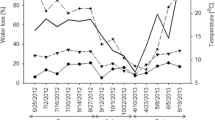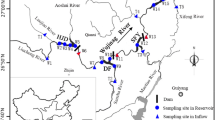Abstract
Complex flow patterns and hydraulic characteristics could reduce the utilization efficiency of constructed wetland (CW), and consequently, its pollutant removal performance. Thus, it is of great importance to explore the internal flow patterns of CWs. Isotopic molecules exist naturally in CWs and have special properties under liquid conditions; using hydrogen and oxygen isotope technology cannot only reduce secondary pollution but also reflect the hydraulic characteristics of CWs. In the present study, the annual variation of isotopic composition in field-scale CW was investigated to evaluate the long-term feasibility of stable isotopic technology characterizing hydraulic flow patterns. The relationship between nutrients concentration distribution and flow pattern variation in CW under different seasons was discussed as well. Results demonstrated that isotope 18O/16O distribution could be used to determine the internal flow pattern of CW throughout the year, except for preferential flow area of CWs in winter, since more hydraulic retention time is needed to ensure the change of water isotopes due to the small evaporation in winter. Lower ammonia nitrogen concentration was observed in the stagnant area, while the total phosphorus concentration of the stagnant area increased during winter. And more attention should be paid to aquatic plants during the CW design, since it has significant influence on the hydraulic flow patterns of CW.






Similar content being viewed by others
References
Aberle J, Jarvela J (2013) Flow resistance of emergent rigid and flexible floodplain vegetation. J Hydraul Res 51:33–45
APHA (2017) Standard methods for the examination of water and wastewater, 23rd edn. American Public Health Association, Washington DC
Bodin H, Mietto A, Ehde PM, Persson J, Weisner SEB (2012) Tracer behaviour and analysis of hydraulics in experimental free water surface wetlands. Ecol Eng 49:201–211
Bugna GC, Grace JM, Hsieh Y (2020) Sensitivity of using stable water isotopic tracers to study the hydrology of isolated wetlands in North Florida. J Hydrol 580:124321
Cheesman AW, Turner BL, Inglett PW, Reddy KR (2010) Phosphorus transformations during decomposition of wetland macrophytes. Environ Sci Technol 44:9265–9271
Chen TY, Kao CM, Yeh TY, Chien HY, Chao C (2006) Application of a constructed wetland for industrial wastewater treatment: a pilot-scale study. Chemosphere 64:497–502
Cui L, Zhang Y, Zhang M, Li W, Zhao X, Li S, Wang Y (2012) Identification and modelling the HRT distribution in subsurface constructed wetland. J Environ Monit 14:3037–3044
Das S, Mazumdar A (2015) Comparison of kinematics of horseshoe vortex at a flat plate and different shaped piers. Int J Fluid Mech Res 42:418–448
Dayem KE, Molnar P, Battisti DS, Roe GH (2010) Lessons learned from oxygen isotopes in modern precipitation applied to interpretation of speleothem records of paleoclimate from eastern Asia. Earth Planet Sci Lett 295:219–230
Doig LE, North RL, Hudson JJ, Hewlett C, Lindenschmidt KE, Liber K (2017) Phosphorus release from sediments in a river-valley reservoir in the northern Great Plains of North America. Hydrobiologia 787:323–339
Fan J, Zhang J, Huu Hao N, Guo W, Yin X (2016) Improving low-temperature performance of surface flow constructed wetlands using Potamogeton crispus L. plant. Bioresour Technol 218:1257–1260
Ferguson RI (2012) River channel slope, flow resistance, and gravel entrainment thresholds. Water Resour Res 48:W05517
Gooddy DC, Lapworth DJ, Bennett SA, Heaton THE, Williams PJ, Surridge BWJ (2016) A multi-stable isotope framework to understand eutrophication in aquatic ecosystems. Water Res 88:623–633
Guo C, Cui Y, Dong B, Liu F (2017) Tracer study of the hydraulic performance of constructed wetlands planted with three different aquatic plant species. Ecol Eng 102:433–442
Gupta P, Noone D, Galewsky J, Sweeney C, Vaughn BH (2009) A new laser-based, field-deployable analyzer for laboratory-class stable isotope measurements in water. Geochim Cosmochim Acta 73:A480–A480
Hua GF, Zhao ZW, Kong J, Guo R, Zeng YT, Zhao LF, Zhu QD (2014) Effects of plant roots on the hydraulic performance during the clogging process in mesocosm vertical flow constructed wetlands. Environ Sci Pollut Res 21:13017–13026
Kele S, Ozkul M, Forizs I, Gokgoz A, Baykara MO, Alcicek MC, Nemeth T (2011) Stable isotope geochemical study of Pamukkale travertines: new evidences of low-temperature non-equilibrium calcite-water fractionation. Sediment Geol 238:191–212
Laurent J, Bois P, Nuel M, Wanko A (2015) Systemic models of full-scale surface flow treatment wetlands: determination by application of fluorescent tracers. Chem Eng J 264:389–398
Lécuyer C, Amiot R, Touzeau A, Trotter J (2013) Calibration of the phosphate δ18O thermometer with carbonate–water oxygen isotope fractionation equations. Chem Geol 347:217–226
Lin AY, Debroux J, Cunningham JA, Reinhard M (2003) Comparison of rhodamine WT and bromide in the determination of hydraulic characteristics of constructed wetlands. Ecol Eng 20:75–88
Liu J, Dong B, Zhou W, Qian Z (2020) Optimal selection of hydraulic indexes with classical test theory to compare hydraulic performance of constructed wetlands. Ecol Eng 143:105687
Min J, Wise WR (2009) Simulating short-circuiting flow in a constructed wetland: the implications of bathymetry and vegetation effects. Hydrol Process 23:830–841
Muste M, Vermeyen T, Hotchkiss R, Oberg K (2007) Acoustic velocimetry for riverine environments. Hydraul Eng 133:1297–1298
Nyantekyi-Kwakye B, Tachie MF, Clark SP, Malenchak J, Muluye GY (2017) Acoustic Doppler velocimeter measurements of a submerged three-dimensional offset jet flow over rough surfaces. J Hydraul Res 55:40–49
Pham N, Penning E, Mynett A, Raghuraj R (2011) Effects of submerged tropical macrophytes on flow resistance and velocity profiles in open channels. Int J River Basin Manag 9:195–203
Plugatyr A, Svishchev IM (2008) Residence time distribution measurements and flow modeling in a supercritical water oxidation reactor: application of transfer function concept. J Supercrit Fluids 44:31–39
Pugliese L, Kusk M, Iversen BV, Kjaergaard C (2020) Internal hydraulics and wind effect in a surface flow constructed wetland receiving agricultural drainage water. Ecol Eng 144:105661
Qi W, Guo Y, Xue M, Li Y (2013) Hydraulic analysis of an upflow sand filter: tracer experiments, mathematical model and CFD computation. Chem Eng Sci 104:460–472
Ronkanen A, Klove B (2007) Use of stabile isotopes and tracers to detect preferential flow patterns in a peatland treating municipal wastewater. J Hydrol 347:418–429
Ronkanen A, Klove B (2008) Hydraulics and flow modelling of water treatment wetlands constructed on peatlands in Northern Finland. Water Res 42:4894–4894
Ruggiero C, De Pascale S, Angelino G, Maggio A (2003) Developmental changes in plant resistance to water flow in Pisum sativum (L.). Plant Soil 250:121–128
State Environmental Protection Administration (2002) Water and wastewater monitoring analysis method, 4th edn. China Environmental Science Press, Beijing
Stein OR, Hook PB (2005) Temperature, plants, and oxygen: how does season affect constructed wetland performance? J Environ Sci Health A 40:1331–1342
Stottmeister U, Wiessner A, Kuschk P, Kappelmeyer U, Kastner M, Bederski O, Muller RA, Moormann H (2003) Effects of plants and microorganisms in constructed wetlands for wastewater treatment. Biotechnol Adv 22:93–117
Sun H, Hu Z, Zhang J, Wu W, Liang S, Lu S, Liu H (2016) Determination of hydraulic flow patterns in constructed wetlands using hydrogen and oxygen isotopes. J Mol Liq 223:775–780
Tang P, Yu B, Zhou Y, Zhang Y, Li J (2017) Clogging development and hydraulic performance of the horizontal subsurface flow stormwater constructed wetlands: a laboratory study. Environ Sci Pollut Res 24:9210–9219
Toet S, Van Logtestijn RSP, Kampf R, Schreijer M, Verhoeven JTA (2005) The effect of hydraulic retention time on the removal of pollutants from sewage treatment plant effluent in a surface-flow wetland system. Wetlands 25:375–391
Vymazal J (2007) Removal of nutrients in various types of constructed wetlands. Sci Total Environ 380:48–65
Vymazal J (2010) Constructed wetlands for wastewater treatment: five decades of experience. C R C Crit Rev Environ Control 31:351–409
Vymazal J (2011) Constructed wetlands for wastewater treatment: five decades of experience. Environ Sci Technol 45:61–69
Wang L, Wang G, Yu Z, Gu X, Chen Q (2010) Effect of submerged plant Potamogeton crispus on the concentrations of phosphorus fractions in overlying water, 2010 IEEE 2nd Symposium on Web Society (SWS 2010). IEEE, Beijing, China, pp 197–200
Woodard R (2000) Interpolation of spatial data: some theory for Kriging. Technometrics 42:436–437
Xiang S, Zhou W (2011) Phosphorus forms and distribution in the sediments of Poyang Lake, China. Int J Sediment Res 26:230–238
Yu J, Yu F, Liu D (1987) Hydrogen and oxygen isotopic compositions of meteoric waters in the eastern part of China. Chin J Geochem 6:367–371
Zhang Y, He F, Xia S, Zhou Q, Wu Z (2015) Studies on the treatment efficiency of sediment phosphorus with a combined technology of PCFM and submerged macrophytes. Environ Pollut 206:705–711
Zheng L, Ding AZ, Kong DC, Cheng LR (2011) Hydraulic characteristics of a pilot-scale vertical subsurface flow constructed wetland, International Conference on Energy, Environment and Sustainable Development (ICEESD 2011). Advanced Materials Research, Shanghai Univ Elect Power, Shanghai, PEOPLES R CHINA, pp 2451–2458
Funding
This work was supported by the National Natural Science Foundation of China (No. 51878388), Natural Science Foundation of Shandong Province (No. ZR2018QEE006), Shandong Provincial Key Research and Development Program (Major Scientific and Technological Innovation Project) (No. 2019JZZY010411), and Future Plan for Young Scholar of Shandong University.
Author information
Authors and Affiliations
Corresponding author
Additional information
Responsible editor: Philippe Garrigues
Publisher’s note
Springer Nature remains neutral with regard to jurisdictional claims in published maps and institutional affiliations.
Rights and permissions
About this article
Cite this article
Gao, H., Lan, W., Sun, H. et al. Annual study of hydraulic characteristics in surface flow constructed wetlands using hydrogen and oxygen stable isotope technology. Environ Sci Pollut Res 27, 29502–29511 (2020). https://doi.org/10.1007/s11356-020-09122-3
Received:
Accepted:
Published:
Issue Date:
DOI: https://doi.org/10.1007/s11356-020-09122-3




